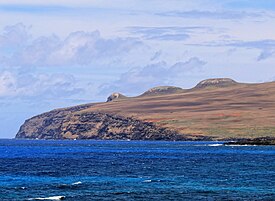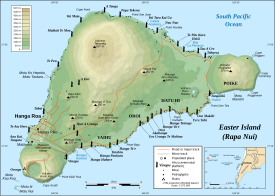Trends in LIMS
Contents


Poike is one of the three main extinct volcanoes that form Rapa Nui (Easter Island), a Chilean island in the Pacific Ocean. At 370 metres above sea level, Poike's peak is the island's second-highest point after the peak of the extinct volcano Terevaka.
Poike forms the eastern headland of Rapa Nui. An abrupt cliff known as the "Poike ditch" spans the island at the boundary between the respective lava flows from Poike and Terevaka. As the oldest of the island's three main volcanoes, Poike is the most weathered with relatively stoneless soil.
See also
References
- Haase, Karsten M.; Stoffers, Peter; Garbe-Schönberg, C. Dieter (October 1997). "The Petrogenetic Evolution of Lavas from Easter Island and Neighbouring Seamounts, Near-ridge Hotspot Volcanoes in the SE Pacific". Journal of Petrology. 38 (6): 785–813. doi:10.1093/petrology/38.6.785.
- Routledge, Katherine. 1919. The Mystery of Easter Island. The story of an expedition. London. [ISBN missing]
- Van Tilburg, Jo Anne. 1994. Easter Island: Archaeology, Ecology and Culture. Washington D.C.: Smithsonian Institution Press. [ISBN missing]
External links
- Guide to Easter Island from the Easter Island Foundation
27°05′31″S 109°15′00″W / 27.09194°S 109.25000°W

















